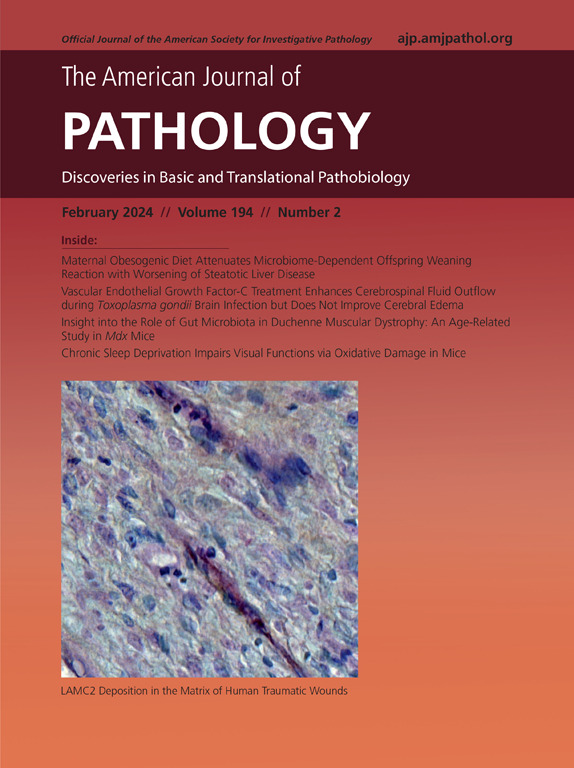Pharmacologic Inhibition of Glutamate Dehydrogenase 1 Improves Functional Recovery of Neuromuscular Junctions and Muscle Function in Duchenne Muscular Dystrophy
IF 3.6
2区 医学
Q1 PATHOLOGY
引用次数: 0
Abstract
Presynaptic terminals of neuromuscular junctions (NMJs) are sensitive to glutamate, which contributes to NMJ plasticity and synaptic neurotransmission. However, the effect of glutamate on neurotransmission and its pharmacologic modulation in muscle pathologies are understudied. In this study, the efficacy of pharmacologic blockade of glutamate dehydrogenase (GLUD)-1 was investigated in mdx mice, a model of Duchenne muscular dystrophy. The GLUD1 inhibitor R162 mitigated the malfunctioning of NMJs by enhancing glutamate release from muscle fibers and increasing its availability in the muscle interstitium. Glutamate binding to its N-methyl-d-aspartate receptor on the presynaptic bottom of NMJs resulted in the increased release of acetylcholine and functional recovery of the action potential and muscle contraction, ultimately improving muscle performance. Finally, the GLUD1 inhibitor did not affect the homeostatic control of NMJs and the behavior of either healthy or dystrophic mice. This study suggests a promising and feasible therapeutic approach, based on muscle glutamate exploitation, to treating Duchenne muscular dystrophy, an unmet need in the clinic.
药物抑制谷氨酸脱氢酶1 (GLUD1)可改善杜氏肌营养不良患者神经肌肉连接功能恢复和肌肉功能。
神经肌肉连接(NMJs)的突触前末端对谷氨酸敏感,这有助于NMJs的可塑性和突触神经传递。然而,谷氨酸对神经传递的影响及其在肌肉病理中的药理调节尚未得到充分研究。在此,我们研究了谷氨酸脱氢酶1 (GLUD1)对杜氏肌营养不良(DMD)模型mdx小鼠的药物阻断作用。GLUD1抑制剂R162通过增强肌纤维中谷氨酸的释放和增加其在肌间质中的可用性来减轻NMJs的功能失调。谷氨酸与NMJs突触前底部的n -甲基- d -天冬氨酸受体(NMDAR)结合,导致乙酰胆碱释放增加,动作电位和肌肉收缩功能恢复,最终改善肌肉性能。最后,GLUD1抑制剂不影响NMJs的稳态控制和健康或营养不良小鼠的行为。本研究提出了一种基于肌谷氨酸开发治疗DMD的有希望和可行的治疗方法,这是迄今为止临床未满足的需求。
本文章由计算机程序翻译,如有差异,请以英文原文为准。
求助全文
约1分钟内获得全文
求助全文
来源期刊
CiteScore
11.40
自引率
0.00%
发文量
178
审稿时长
30 days
期刊介绍:
The American Journal of Pathology, official journal of the American Society for Investigative Pathology, published by Elsevier, Inc., seeks high-quality original research reports, reviews, and commentaries related to the molecular and cellular basis of disease. The editors will consider basic, translational, and clinical investigations that directly address mechanisms of pathogenesis or provide a foundation for future mechanistic inquiries. Examples of such foundational investigations include data mining, identification of biomarkers, molecular pathology, and discovery research. Foundational studies that incorporate deep learning and artificial intelligence are also welcome. High priority is given to studies of human disease and relevant experimental models using molecular, cellular, and organismal approaches.

 求助内容:
求助内容: 应助结果提醒方式:
应助结果提醒方式:


